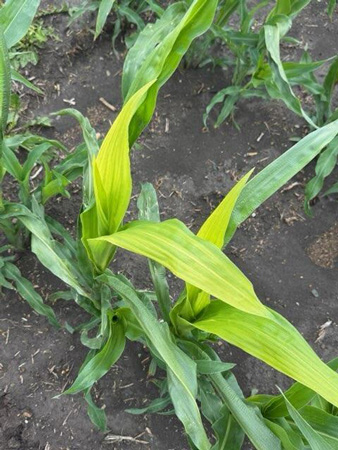Some corn fields in Kansas have shown signs of abnormal growth, where the whorls of the affected corn plants are tightly twisted or even bent over. This is referred to as “rapid growth syndrome”, a physiological condition that typically occurs during periods of accelerated growth, particularly after a phase of cool, wet weather. The typical sequence includes:
- Cool, cloudy, and wet conditions. These restrict plant development, photosynthesis, and nutrient uptake.
- Sudden onset of warm, sunny weather. This triggers a burst of growth in the plant, leading to the physiological symptoms described above.
Rapid growth syndrome is most commonly observed between V5 and V8 growth stages, though it can occur as late as V12. Key symptoms include:
- Twisted or buggy-whipped whorls: New leaves may fail to unfurl properly and emerge in a tightly coiled form (Figure 1, left and center photo).
- Wrinkled, crinkled, or translucent leaves: As leaves eventually emerge, they may appear malformed or discolored (Figure 1, right). When leaves do eventually unfurl, they are often a pale green or yellowish (Figure 2), but will soon return to normal.
- Purpling or yellowing: Nutrient deficiencies can become more apparent due to the sudden demand during rapid growth.
- Lodging: In severe cases, weak stalks may bend or collapse under their own weight.

Figure 1. Twisted leaves or "buggy whipping" (left and center photos) and wrinkled leaves (right photo) are all examples of physiological responses to rapid growth in corn. Photos by Sarah Lancaster and David Hallauer, K-State Research and Extension.

Figure 2. Examples of corn leaves with yellow or pale green discoloration due to rapid growth syndrome. Photo by Sarah Lancaster, K-State Research and Extension.
This syndrome can resemble herbicide injury, particularly injury from group 4 herbicides like 2,4-D or group 15 herbicides such as S-metolachlor (Dual, others), acetochlor (Harness, others), and dimethenamid-P (Outlook, others). Rapid growth syndrome can often be distinguished by:
Timing of injury symptoms: Rapid growth syndrome occurs during periods of rapid growth following environmental stress, rather than during cool, wet conditions that keep the plant from metabolizing the herbicide.
Pattern of injury: Rapid growth syndrome injury will be more sporadic and not associated with application patterns or soil conditions than herbicide injury.
Recovery pattern: New leaves unfurl and eventually look ‘normal’ following rapid growth syndrome, but plant parts affected by herbicides may retain injury symptoms, even if new growth is ‘normal’. In addition, plants with foliar herbicide injury caused by group 4 herbicides may also have injury to brace root.
In summary
The good news is that affected plants usually recover within a week with minimal to no yield effects. The leaves affected may have a rippled appearance, while the inner leaves are yellow to pale yellow (Figure 2). The yellowing should darken back to green as photosynthesis occurs. Severe cases of rapid growth syndrome may lead to plant lodging, affecting harvest efficiency.
Sarah Lancaster, Extension Weed Science Specialist
slancaster@ksu.edu
Tina Sullivan, Northeast Area Agronomist
tsullivan@ksu.edu
Tags: weather corn rapid growth syndrome